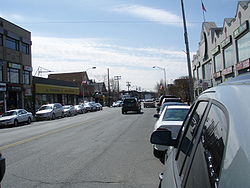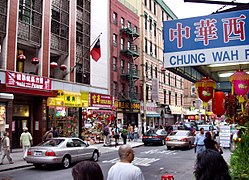| Ethnic enclaves in North American cities | |
|---|---|
 New York City is home to the largest overseas Chinese population of any city proper in the Western Hemisphere, with over half million. Multiple large Chinatowns in Manhattan, Brooklyn (above), and Queens are thriving as traditionally urban ethnic enclaves, as large-scale Chinese immigration continues into New York, [1] [2] [3] [4] with the largest metropolitan Chinese population outside of Asia. [5] |


This is a list of ethnic enclaves in various countries of different ethnic and cultural backgrounds to the native population. An ethnic enclave in this context denotes an area primarily populated by a population with similar ethnic or racial background. This list also includes concentrations rather than enclaves,and historic examples which may no longer be an ethnic enclave. [9]
Contents
- Africa
- African Americans
- Angola
- Benin
- Cameroon
- Cape Verde
- Congo (Brazzaville and DRC)
- Côte d'Ivoire
- Ethiopia
- Eritrea
- Nigeria
- Somalia
- Other or pan-African
- Asia (East,South and Southeast)
- Afghanistan
- Bangladesh
- Burma/Myanmar
- Cambodia
- China
- Hmong
- India
- Japan
- Korea
- Laos
- Pakistan
- Philippines
- Sri Lanka
- Thailand
- Vietnam
- European or Anglo origin
- Australia
- Albania
- Basque
- Belarus
- Belgium
- Bosnian
- Croatia
- Eastern European Jewish
- France
- Germany
- Georgia
- Greece
- Ireland
- Italy
- Luxembourg
- Malta
- Poland
- Portugal
- Romania
- Russia
- Scandinavia
- Serbia
- Slovenia
- United Kingdom
- Middle East
- Armenia
- Assyrians
- Kurds
- Palestinian
- Iran
- Yemen
- Latin America and Caribbean
- Guatemala
- El Salvador
- Mexico
- West Indies and Caribbean
- Pacific Islands and Oceania
- Samoa
- Tonga
- Marshall Islands
- Fiji
- Micronesia
- Guam and the Northern Mariana Islands (Chamorro and Carolinians)
- Others
- Jews (of many nationalities)
- Native Americans
- See also
- References
- External links






